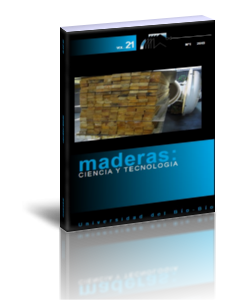Specific gas permeability of normal and nanosilver-impregnated solid wood species as influenced by heat-treatment
Keywords:
Beech, poplar, fir, longitudinal permeability, wood-modificationAbstract
The effect of heat treatment at 50 and up to 150°C was studied on dowel-shape specimens prepared from beech (Fagus orientalis), poplar (Populus nigra), and fir (Abies alba) wood. Specimens were cut into two diameter sizes (18 and 25mm) to explore the effect of diameter size on permeability. Separate sets of specimens from each size and species were prepared to be first impregnated with a 200 ppm aqueous nanosilver (NS) suspension to investigate the effect of facilitated heat-transfer on permeability at different temperatures. Specimens were heated in five consecutive steps at 50, 75, 100, 125, and 150°C and for 24 hours in each step. High variance was found in the specific gas permeability between each treatment group, thus indicating probable high fluctuation in settlement of extractives at different spots of a log. Heat treatment only affected gas permeability at the first steps of heating (50 and 75°C), where loss of moisture content resulted in a permeability increase in nearly all species. Consecutive steps of heating up to 150°C did not significantly affect the permeability in either normal or NS-impregnated specimens.
Downloads
References
Ayata, U.; Akcay, C.; Esteves, B. 2017. Determination of decay resistance against Pleurotus ostreatus and Coniophora puteana fungus of heat-treated Scotch pine, oak and beech wood species. Maderas-Cienc Tecnol 19(3): 309-316.
Esmailpour, A.; Taghiyari, H.R.; Zolfaghari, H. 2017. Effects of heat treatment on sound absorption coefficients in nanosilver-impregnated and normal solid woods. IET Nanobiotechnology 11(4): 365-369.
Figueroa, M.; Bustos, C.; Dechent, P.; Reyes, L.; Cloutier, A.; Giuliano, M. 2012. Analysis of rheological and thermo-hygro-mechanical behaviour of stress-laminated timber bridge deck in variable environmental conditions. Maderas-Cienc Tecnol 14(3): 303-319.
Ghorbani, M.; Akhtari, M.; Taghiyari, H.R.; Kalantari, A. 2012. Effects of silver and zinc-oxide nanoparticles on gas and liquid permeability of heat-treated Paulownia wood. Austrian J Forest Sci 129(1): 106-123.
Hill, C. 2006. Wood Modification Chemical, Thermal and Other Processes. John Wiley & Sons, Ltd., ISBN: 0-470-02172-1; pp 239.
Imamura, H. 1989. Contribution of extractives to wood characteristics. In: Rowe, JW (eds) Natural Products of Woody Plants. Springer Series in Wood Science: Springer, Berlin, Heidelberg. pp 843 - 860.
Ismita, N.; Lokesh, C. 2017. Effects of different nanoclay loadings on the physical and mechanical properties of Melia composite particle board. Bois et Forets des Tropiques 334(4): 7-12.
Majidi, R. 2016. Electronic properties of graphyne nanotubes filled with small fullerenes: A density functional theory study. Journal of Computational Electronics 15(4): 1263-1268.
Matinise, N.; Fuku, X.; Maaza, M. 2016. Fabrication of Mixed Phase Bimetallic Zinc Cobaltite Nanocomposite via Moringa Oleifera Green Synthesis. Journal of Nanomaterial & Molecular Nanotechnology 5:6-6.
Muñoz, F.; Moya, R. 2018. Effect of nanoclay-treated UF resin on the physical and mechanical properties of plywood manufactured with wood from tropical fast growth plantations. Maderas-Cienc Tecnol 20(1): 11-24.
Papadopoulos, A. 2012. Sorption of acetylated pine wood decayed by brown rot, white rot, and soft rot: different fungi - different behavior. Wood Sci Technol 46(5): 919 - 926.
Pethig, R. 2017. Review - Where is dielectrophoresis (DEP) going? Journal of the Electrochemical Society 164(5): B3049 - B3055.
Poonia, P.K.; Hom, S.K.; Sihag, K.; Tripathi, S. 2016. Effect of microwave treatment on longitudinal air permeability and preservative uptake characteristics of chir pine wood. Maderas-Cienc Tecnol 18(1): 125-132.
Salman, S.; Thevenon, M.F.; Petrissans, A.; Dumarcay, S.; Candelier, K.; Gerardin, P. 2017. Improvement of the durability of heat-treated wood against termites. Maderas- Cienc Tecnol 19(3): 317-328.
Shi, S.H.Q. 2007. Diffusion model based on Fick’s second law for the moisture absorption process in wood fiber-based composites: is it suitable or not? Wood Sci Technol 41(8): 645-658.
Siau, J.F. 1995. Wood: Influence of Moisture on Physical Properties. Blacksburg, VA: Department of Wood Science and Forest Products Virginian Polytechnic Institute and State University, 1-63.
Suganya, S.; Kumar, P.S.; Saravanan, A. 2017. Construction of active bio-nanocomposite by inseminated metal nanoparticles onto activated carbon: probing to antimicrobial activity. IET Nanobiotechnology 11(6): 746-753.
Taghiyari, H.R.; Karimi, A.N.; Parsapajouh, D.; Pourtahmasi, K. 2010. Study on the longitudinal gas permeability of juvenile wood and mature wood. Special Topics & Reviews in Porous Media 1(1): 31-38.
Taghiyari, H.R.; Layeghi, M.; Aminzadeh-Liyafooee, F. 2012. Effects of dry ice on gas permeability of nano-silver-impregnated Populus nigra and Fagus orientalis. IET Nanobiotechnology 6(2): 40-44.
Taghiyari, H.R.; Mobini, K.; Sarvari-Samadi, Y.; Doosti, Z.; Karimi, F.; Asghari, M.; Jahangiri, A.; Nouri, P. 2013. Effects of nano-wollastonite on thermal conductivity coefficient of medium-density fiberboard. Journal of Nanomaterials & Molecular Nanotechnology 2:1

































